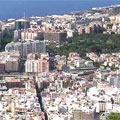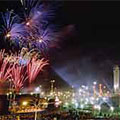
This town is a part of the province with the same name and is also considered as the capital of the Island and the Autonomous Community of the Canary Isles, an honor it shares with Las Palmas of Grand Canary.
It is located on the northeast part of the Island of Tenerife in an area washed by the waters of the Atlantic Ocean and the city is erected between the bay with the same name and the Anaga Massif.
It has an area of 150.56 square kilometers and in January 2005 the population numbered 221 567 inhabitants. It is perhaps because the town has nearly 60 kilometers of coast, together with an abrupt orography, that the weather can be considered to be arid with scarce rains reaching an average of a little less than 300 millimeters a year.
Captain-general Alonso Fernández de Lugo was the founder of the city in 1494 and as early as the 16th century the first traces of roads appeared. However, it was not until the 18 th century that the city began to take off mostly due to the gradual commercial development of its harbor, which consequently resulted in the establishment of the harbour master’s office there in 1723.
 It should be noted that the harbour soon became one of the most important harbours in the Atlantic Ocean, as the Canary Isles were an unavoidable passage for the fleet bound for the Americas. The city achieved such an incredible development that in the 19 th century, under the rule of Ferdinand VII, the capital status of Tenerife was moved from La Laguna to Santa Cruz.
It should be noted that the harbour soon became one of the most important harbours in the Atlantic Ocean, as the Canary Isles were an unavoidable passage for the fleet bound for the Americas. The city achieved such an incredible development that in the 19 th century, under the rule of Ferdinand VII, the capital status of Tenerife was moved from La Laguna to Santa Cruz.
La Laguna (The Lagoon) had been to that date the main center for business transactions, but as it lost strength due to the aforementioned reasons and the expansion of the old center of Santa Cruz de Tenerife to the northeast in the 19 th century, the urban plan acquired a radial layout.
A period of distress and bloodshed had been left behind, because during the 18 th and 19 th centuries the city underwent despicable English and Dutch pirates’ attacks. Admiral Nelson’s attack should be highlighted, as he lost one arm in an attempt to take over the territory, when he was shot by a cannon Tiger bullet, an artifact that is shown today at the Army’s Museum.
Once the chapter of pirates’ attacks was closed, the port began to recover and expand its horizons. Therefore since the early 20 th century the necessary changes began to be made for Tenerife harbour to go along with the economic development that was taking place at that time.
In 1907 the Board of Harbor Works was founded, a body that would be responsible for concluding the works that had been previously initiated. History says that in 1911 engineer Pedro Matos managed to get permission for an extension of the outer dock or southern pier as well as the creation of a new dock or breakwater that is known today as the North Pier, previously proposed by his predecessor Prudencio Guadalfajara.
Constant changes grew stronger at the beginning of the second half of the 20 th century when the plans made by Miguel Pintor became a reality. Such plans envisaged the creation of the riverside quays, covering the original coast of Santa Cruz to gain a bigger mooring line. In the meantime, a special dock for smaller boats emerged as a fishing dock and so it did not interrupt operations at the main quay.
Likewise, a commercial dock (Southern Dock) was built, which is the most troublesome one due to its unfavorable position when the south wind blows.
However, the harbor has increased its operations as new needs have to be met as is the case of La Hondura quay for refinery materials trading and Bufadero quay, exclusively used for goods.
To sum up, Santa Cruz de Tenerife has a distinctive touch in its harbour and inhabitants. This city, just like the island, vibrates to the beat of a strong economic and social growth supported by an invaluable tourist development.